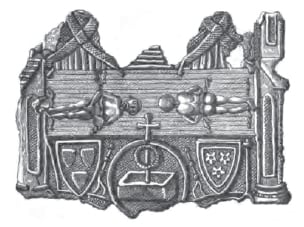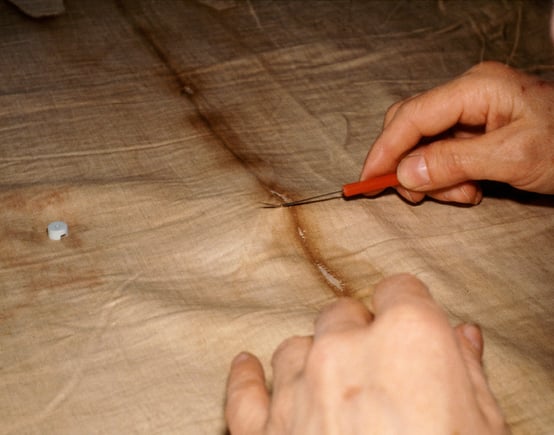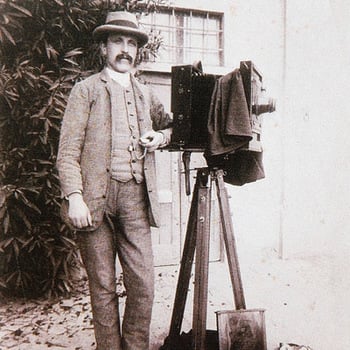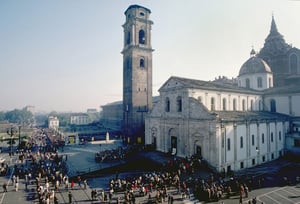The Shroud of Turin, or the burial cloth of Jesus, first appeared in 1349 in historical documents associated with the 14th century French crusader, Geoffrey de Charnay.
Geoffrey de Charnay was married to Jeanne de Vergy, a 5th generation descendent of Othon de la Roche and a leader of the 4th crusade. This is significant because the 4th crusade ended in the sack of Constantinople, and biological evidence confirms the Shroud’s presence in that region.
 Drawing of a pilgrim badge found in the Seine river, under the "Pont-au-Change" bridge (Paris, France), in 1855. The badge bears a representation of the Shroud of Lirey (Shroud of Turin), the arms of Charny and those of Vergy. The badge is in the Musée National du Moyen Âge, Thermes de Cluny, Paris. / Arthur Forgeais (1822-1878) [Public domain]
Drawing of a pilgrim badge found in the Seine river, under the "Pont-au-Change" bridge (Paris, France), in 1855. The badge bears a representation of the Shroud of Lirey (Shroud of Turin), the arms of Charny and those of Vergy. The badge is in the Musée National du Moyen Âge, Thermes de Cluny, Paris. / Arthur Forgeais (1822-1878) [Public domain]
Additionally, there are striking facial similarities to a well documented relic from Constantinople: the Mandylion or the Image of Edessa. It is likely that the Shroud was in the possession of this family from 1204 AD and may have been part of Jeanne de Vergy’s dowry.
Well documented history
- 1349: The Shroud surfaces in Lirey, France, and is put on display in 1355.
- 1453: Ownership of Shroud transferred to the Duke of Savoy, Geneva.
- 1471: Enlargement and embellishment of the Duke’s' chapel at Chambéry where the Shroud is eventually relocated.
- 1532: Fire of Chambery causes scorch marks and other damage.
- 1534: Poor Clare nuns “mend” the damage to the Shroud.
- 1578: The Shroud arrives in Turin, Italy. This was at the request of the Bishop of Turin, so that the saintly, but sickly, Archbishop of Milan, Charles Borromeo, could venerate it. It has been housed in and around St. John the Baptist Cathedral, Turin, since then.
 A single thread is removed from the Shroud by one of the Poor Clare nuns using a fine dissecting needle. ©1978 Barrie M. Schwortz Collection, STERA, Inc.
A single thread is removed from the Shroud by one of the Poor Clare nuns using a fine dissecting needle. ©1978 Barrie M. Schwortz Collection, STERA, Inc.The Shroud has also made it into history in modern times. Key dates include the following:
- 1898: First photographs, taken by Secondo Pia, reveal a positive image, showing that the image itself is indeed a negative.
- 1902: Sorbonne University professor, Yves Delage, argues the Shroud is the authentic burial cloth of Jesus.
- 1939-1945: The Shroud is hidden in a monastery during WWII.
- 1973: Scientists allowed to take samples for study.
- 1978: Two major events: Publication of Ian Wilson’s book, "The Shroud of Turin: The Burial Cloth of Jesus Christ?" in which the Shroud is identified as the Image of Edessa, the Mandylion; and investigation by 30 scientists, known as STURP confirm image is of a real “scourged, crucified man… not the product of an artist."
- 1983: Shroud ownership is given to the Vatican.
- 1988: Carbon-dating tests report origins between 1260 and 1390—results now known to be inaccurate due to faulty sampling (see Chapter 4 below).
- 1997: Fire in Turin Cathedral as a result of arson. The Shroud was rescued by local firefighters.
- 2002: Ray Rogers, skeptic and original member of STURP, publishes a paper questioning 1988 samples.
- 2008: UV radiation hypothesis for the formation of the Shroud’s image put forward by John Jackson’s team of investigators.
- 2010: Paolo Di Lazzaro’s team experimentally substantiates Jackson’s hypothesis.
- 2013: Dr. Guilio Fanti and Saverio Gaeta write the book, The Mystery of The Shroud, documenting likely 1st century origins.
 Secundo Pia, first to photograph the Shroud of Turin
Secundo Pia, first to photograph the Shroud of Turin
For a more condensed timeline, go here.
Featured Image: Crowds wait in line in front of the Turin Cathedral to see the Shroud while it is on public display in 1978. ©1978 Barrie M. Schwortz Collection, STERA, Inc.
More on the Shroud of Turin
If you would like to learn more about the Shroud of Turin, see the 5 other articles in this series:


